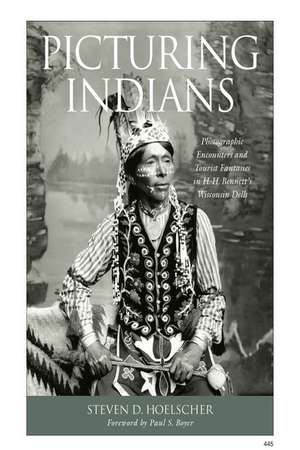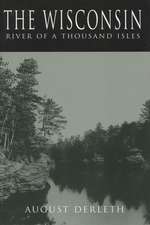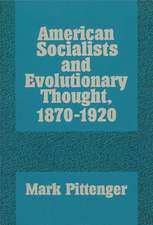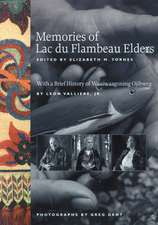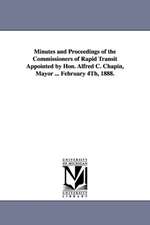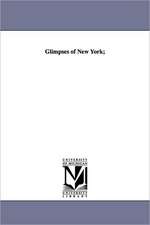Picturing Indians: Photographic Encounters and Tourist Fantasies in H. H. Bennett's Wisconsin Dells: Studies in American Thought and Culture
Autor Steven D. Hoelscher Cuvânt înainte de Paul S. Boyeren Limba Engleză Paperback – 17 iul 2008
Today a tourist mecca, the area now known as the Wisconsin Dells was once wilderness—and a gathering place for the region’s Native peoples, the Ho-Chunk, who for centuries migrated to this part of the Wisconsin River for both sustenance and spiritual renewal. By the late 1800s their numbers had dwindled through displacement or forcible removal, and it was this smaller band that caught the attention of photographer Henry Hamilton Bennett. Having built his reputation on his photographs of the Dells’ steep gorges and fantastic rock formations, H. H. Bennett now turned his camera upon the Ho-Chunk themselves, and thus began the many-layered relationship unfolded by Steven D. Hoelscher in Picturing Indians: Photographic Encounters and Tourist Fantasies in H. H. Bennett’s Wisconsin Dells.
The interactions between Indian and white man, photographer and photographed, suggested a relationship in which commercial motives and friendly feelings mixed, though not necessarily in equal measure. The Ho-Chunk resourcefully sought new ways to survive in the increasingly tourist-driven economy of the Dells. Bennett, struggling to keep his photography business alive, capitalized on America’s comfortably nostalgic image of Native peoples as a vanishing race, no longer threatening and now safe for white consumption.
Hoelscher traces these developments through letters, diaries, financial records, guidebooks, and periodicals of the day. He places Bennett within the context of contemporary artists and photographers of American Indians and examines the receptions of this legacy by the Ho-Chunk today. In the final chapter, he juxtaposes Bennett’s depictions of Native Americans with the work of present-day Ho-Chunk photographer Tom Jones, who documents the lives of his own people with a subtlety and depth foreshadowed, a century ago, in the flickers of irony, injury, humor, and pride conveyed by his Ho-Chunk ancestors as they posed before the lens of a white photographer.
Winner, Book Award of Merit, Wisconsin Historical Society, Best Books for General Audiences, selected by the American Association of School Librarians, and Best Books for Regional Interests, selected by the Public Library Association
Din seria Studies in American Thought and Culture
-
 Preț: 212.38 lei
Preț: 212.38 lei -
 Preț: 172.18 lei
Preț: 172.18 lei -
 Preț: 155.96 lei
Preț: 155.96 lei -
 Preț: 244.08 lei
Preț: 244.08 lei -
 Preț: 279.67 lei
Preț: 279.67 lei -
 Preț: 191.22 lei
Preț: 191.22 lei -
 Preț: 222.55 lei
Preț: 222.55 lei - 11%
 Preț: 206.75 lei
Preț: 206.75 lei -
 Preț: 182.69 lei
Preț: 182.69 lei -
 Preț: 257.78 lei
Preț: 257.78 lei -
 Preț: 231.97 lei
Preț: 231.97 lei -
 Preț: 258.48 lei
Preț: 258.48 lei -
 Preț: 309.44 lei
Preț: 309.44 lei -
 Preț: 233.89 lei
Preț: 233.89 lei -
 Preț: 196.94 lei
Preț: 196.94 lei - 11%
 Preț: 230.50 lei
Preț: 230.50 lei - 11%
 Preț: 229.11 lei
Preț: 229.11 lei - 12%
 Preț: 267.58 lei
Preț: 267.58 lei
Preț: 145.83 lei
Nou
Puncte Express: 219
Preț estimativ în valută:
27.91€ • 30.33$ • 23.46£
27.91€ • 30.33$ • 23.46£
Carte disponibilă
Livrare economică 31 martie-14 aprilie
Preluare comenzi: 021 569.72.76
Specificații
ISBN-13: 9780299226046
ISBN-10: 0299226042
Pagini: 224
Ilustrații: 86 b-w photos, 3 maps, 1 chart
Dimensiuni: 203 x 254 x 10 mm
Greutate: 0.43 kg
Ediția:1
Editura: University of Wisconsin Press
Colecția University of Wisconsin Press
Seria Studies in American Thought and Culture
ISBN-10: 0299226042
Pagini: 224
Ilustrații: 86 b-w photos, 3 maps, 1 chart
Dimensiuni: 203 x 254 x 10 mm
Greutate: 0.43 kg
Ediția:1
Editura: University of Wisconsin Press
Colecția University of Wisconsin Press
Seria Studies in American Thought and Culture
Recenzii
“Picturing Indians triangulates in brilliant fashion the cultural politics of Ho-Chunk life and labor, the imaginative and material shaping of the Wisconsin landscape, and the changing tourist landscape of photographs and curios at the turn of the twentieth century. . . . A fascinating and compelling book!”—Philip Deloria, University of Michigan, author of Indians in Unexpected Places
“A model for photographic research.”—Martha A. Sandweiss, Amherst College, author of Print the Legend: Photography and the American West
“Highly readable and authoritative text . . . . Highly recommended.”—Choice
“A brilliant analysis of the cultural interplay between Native and American communities.”—Biography
“In Picturing Indians: Photographic Encounters and Tourist Fantasies in H.H. Bennett's Wisconsin Dells, Hoelscher superbly braids three threads—a photographer, a native people, an economy - to portray an important part of our national story.”—Geeta Sharma Jensen, Milwaukee Journal Sentinel
“Hoelscher's carefully researched chapters—he had access to all of the photographer's papers, including diaries, financial ledgers and 11-by-17 glass plates—round out the photographic record, making this a thoroughly satisfying book.”—Geeta Sharma Jensen, Milwaukee Journal Sentinel
“You think you know the Dells? Not unless you’ve read Picturing Indians, a detailed, sometimes academic look at the intersection between nature, Native Americans and early photography. H. H. Bennett's black-and-white views of the Dells are well known as the spark that set off the tourist industry there, but Hoelscher uncovers more about Bennett's pioneering portraits of the area's native Ho-Chunk — plus faked photos of the same. . . . [Hoelscher’s] photographic record makes available Dells history that might otherwise have been lost. And the historic photos reproduced throughout are gorgeous.”—Linda Falkenstein, Isthmus
Notă biografică
Steven D. Hoelscher is associate professor of American studies and geography at the University of Texas at Austin. He is the author of Heritage on Stage: The Invention of Ethnic Place in America's Little Switzerland, also published by the University of Wisconsin Press.
Cuprins
Contents
List of Illustrations
Foreword
Acknowledgments
Prologue: Photographic Encounters
1. Contact Zones: American Indians, Tourism, and Photography
2. "Viewing" Indians and Landscape in Nineteenth-Century Wisconsin
3. Ho-Chunk Removals, Returns, and Survivance
4. Visual Dimensions of Bennett's Ho-Chunk Photographs
5. Photographic Practices as Profit-Driven Exchanges
6. The Changing Political Economy of Indian Photography and Art
Epilogue: Picturing Ho-Chunk Today
Notes
Selected Bibliography
Index
Descriere
Having built his reputation on his photographs of the Dells’ steep gorges and fantastic rock formations, H. H. Bennett turned his camera upon the Ho-Chunk, and thus began the many-layered relationship. The interactions between Indian and white man, photographer and photographed, suggested a relationship in which commercial motives and friendly feelings mixed, though not necessarily in equal measure.
